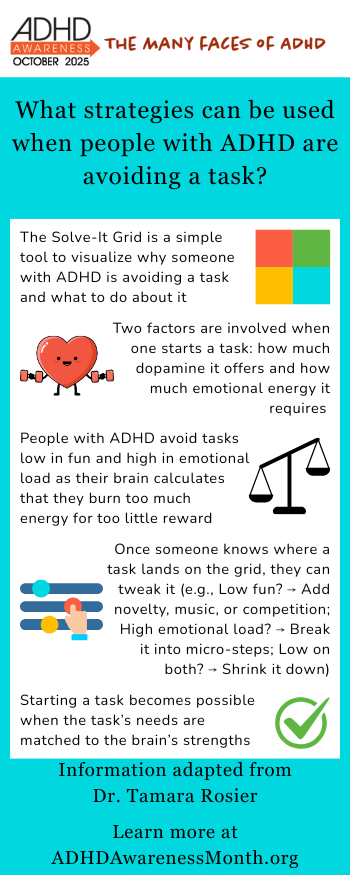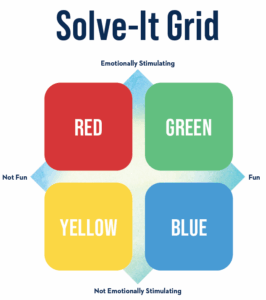Starting a task with ADHD isn’t about willpower — it’s about how your brain understands time, energy, and motivation. The Solve-It Grid helps you figure out why you’re avoiding something by mapping its Fun Factor and Rocket Fuel Factor. Once you see where it lands, you can tweak the task so your brain says, “Let’s do this.”
When you live with ADHD, starting a task isn’t just about knowing it needs to be done. Your brain runs on a different operating system, and whether you start something depends on two key factors: how much dopamine it offers and how much emotional energy it requires. The Solve-It Grid is a simple tool to help you see why you’re stalling — and what to do about it.
The grid maps tasks along two axes:
- Fun Factor – How interesting, novel, or rewarding the task feels right now.
- Rocket Fuel Factor – How much emotional energy you think it will take to get it done.
Every task you face falls somewhere on this map. If a task has a high Fun Factor and low Rocket Fuel Factor, it’s easy to jump in — these are your “low-hanging fruit” tasks. But if a task is low in fun and high in emotional load, that’s the “avoid at all costs” zone. It’s not laziness; your brain is calculating that it will burn too much energy for too little reward.
Once you know where a task lands, you can adjust. Low fun? Add novelty, music, or competition. High emotional load? Break it into micro-steps or add support, like body-doubling. Low on both? Shrink it down so small that your brain sees it as “no big deal.”
The Solve-It Grid works because it externalizes your decision-making. Instead of silently judging yourself for procrastinating, you see why the task feels hard — and you get options to make it feel doable. When you match the task’s needs to your brain’s strengths, starting becomes possible, and finishing becomes much more likely.
About the Author

Dr. Tamara Rosier is the founder of the ADHD Center of West Michigan, where she leads a team dedicated to supporting individuals and families in understanding and managing their unique challenges. She is the author of Your Brain’s Not Broken and You, Me, and Our ADHD Family, which provides practical strategies for navigating the emotional complexities of neurodivergence and personal growth.
Content of the Grid shown above
Adults with ADHD have a peculiar relationship with time, often investing it frivolously or ineffectively. Many of us feel anxiety, guilt, or self-loathing when we think about how we use our days, resulting in more wasted energy and time. Routine tasks, like laundry and paying the bills, frustrate us. When we look at those who don’t have ADHD, we wonder, Why are ordinary tasks so difficult for us to accomplish?
We see our world in predictable ways. We divide our tasks into two categories—fun and not fun. The ADHD brain searches the horizon for the interesting, shiny, curious, remarkable, and exciting, and we call it all “fun.” We are captivated by fun—it affects our levels of drive, motivation, and happiness.
People with ADHD see the world through their emotions. Our brains are wired to detect even mild levels of stimulation. It doesn’t matter if it is positive or negative stimulation; something gets our attention and we respond. We experience negative emotional stimulation when the electric bill we avoided paying is overdue. We experience positive emotional stimulation when we look forward to going golfing with friends. Some tasks, though, have no emotional stimulation.
The RED quadrant is made up of the Not Fun and Emotionally Stimulating. “How can something be not fun and get my emotional attention?” we may wonder, until we realize that we use the RED quadrant to finish many of our tasks. Procrastination, our favorite practice of delaying a task until it requires immediate attention, is an example of using our time in the RED quadrant. The RED preys on our anxiety and causes us to want to respond quickly. It is an addictive, resource-intensive place where we feel a sense of accomplishment.
The YELLOW quadrant is made up of Not Fun and Not Emotionally Stimulating. Our immediate response is “yuck.” The YELLOW quadrant tasks are made up of items that we find distasteful and boring. They are the things that we do to look like a grown-up, such as housework, logging sales calls at the end of the week, and balancing our checkbooks. We know that the items in this quadrant aren’t difficult; they just don’t have our interest.
The BLUE quadrant, Fun but Not Emotionally Stimulating, can be a seductive, hypnotic trap. When we want to distract ourselves from the work of YELLOW and RED quadrants, we turn to BLUE. We tell ourselves that we will check Facebook for just a moment” and then realize that two hours of clicking have gone by. Just like the other quadran=ts, BLUE quadrant activities are different for each person, but the danger is the same—the mire of wasting time or avoiding what we really need to do. To be clear, the BLUE quadrant isn’t bad, but the amount of time we spend in it often deters us from being productive. Some time spent in BLUE is useful because it gives our busy brains a rest and allows for a type of quiet play. The Goldilocks rule applies to the BLUE quadrant. Too little of BLUE makes us anxious for play and rest. Too much BLUE makes us sluggish and resistant to accomplishing tasks. Instead, look for the “just right” amount of time in BLUE.
The GREEN quadrant is our ideal. This Fun and Emotionally Stimulating quadrant seems like paradise at first, but this is where those of us with ADHD get a bit odd. The GREEN quadrant gives us space to build relationships, reflect on personal growth, be creative, and enjoy our lives. It often refocuses our purposes and goals, reminding us what is truly important. In this way, GREEN has a transformative effect on our lives. These activities could include spending time with family and friends, going for a walk on a beautiful day, seeing beautiful artwork, or watching the sunset. We know we experience GREEN when we feel deeply refreshed, more hopeful, and more our true selves. We want to be good at GREEN time, and yet most of us aren’t. We often feel as if we don’t deserve it or don’t want to take the time to invest in it.


